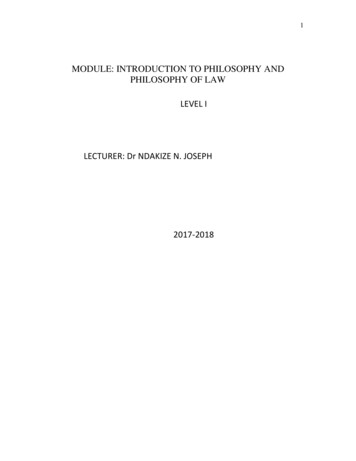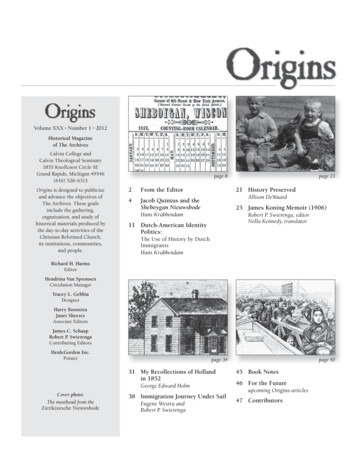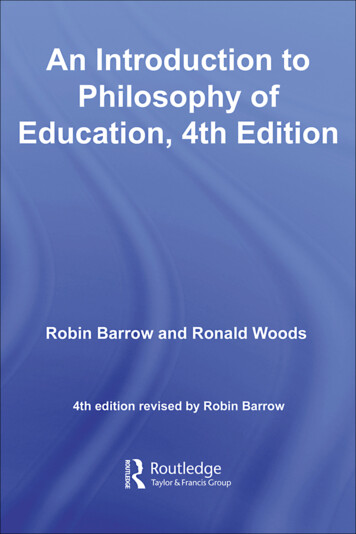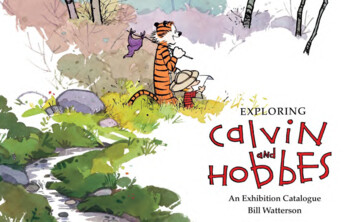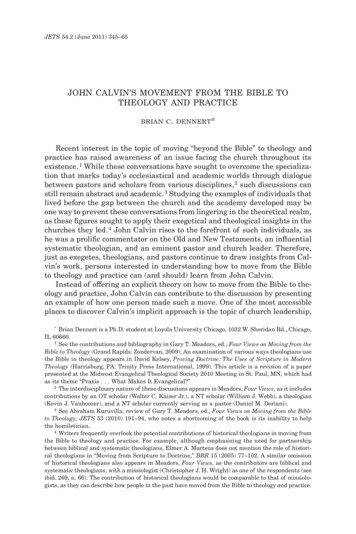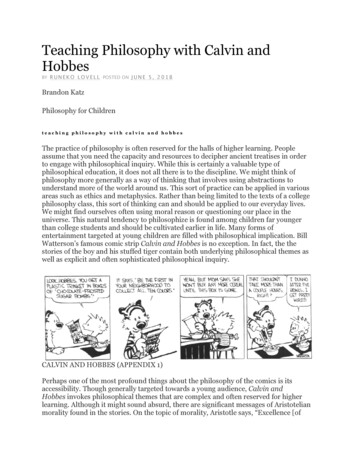
Transcription
Teaching Philosophy with Calvin andHobbesBY R U N E K O L O V E L L POSTED ON J U N E 5 , 2 0 1 8Brandon KatzPhilosophy for Childrenteaching philosophy with calvin and hobbesThe practice of philosophy is often reserved for the halls of higher learning. Peopleassume that you need the capacity and resources to decipher ancient treatises in orderto engage with philosophical inquiry. While this is certainly a valuable type ofphilosophical education, it does not all there is to the discipline. We might think ofphilosophy more generally as a way of thinking that involves using abstractions tounderstand more of the world around us. This sort of practice can be applied in variousareas such as ethics and metaphysics. Rather than being limited to the texts of a collegephilosophy class, this sort of thinking can and should be applied to our everyday lives.We might find ourselves often using moral reason or questioning our place in theuniverse. This natural tendency to philosophize is found among children far youngerthan college students and should be cultivated earlier in life. Many forms ofentertainment targeted at young children are filled with philosophical implication. BillWatterson’s famous comic strip Calvin and Hobbes is no exception. In fact, the thestories of the boy and his stuffed tiger contain both underlying philosophical themes aswell as explicit and often sophisticated philosophical inquiry.CALVIN AND HOBBES (APPENDIX 1)Perhaps one of the most profound things about the philosophy of the comics is itsaccessibility. Though generally targeted towards a young audience, Calvin andHobbes invokes philosophical themes that are complex and often reserved for higherlearning. Although it might sound absurd, there are significant messages of Aristotelianmorality found in the stories. On the topic of morality, Aristotle says, “Excellence [of
character], then, is a state concerned with choice, lying in a mean relative to us, thisbeing determined by reason and in the way in which the man of practical wisdom woulddetermine it. Now it is a mean between two vices, that which depends on excess and thatwhich depends on defect” (Nicomachean Ethics). This passage by Aristotle invokescommon themes of classical western philosophy. By saying that character depends onmaking choices, he is invoking the classical view of nature. He believes that there is acertain sort of moral character that nature endows, and people must makes choices thatline up with this natural morality. Such a sense of morality relies on moderation,another classical virtue.One commentator praised Calvin and Hobbes as “our only popular explication of themoral philosophy of Aristotle” (Wilson). This is quite a significant statement to makeabout a children’s comic, but might not be without merit. Throughout Calvin andHobbes, we see Aristotelian themes arises time and time again. First, there is thecharacter of Calvin, marked by self-indulgence if nothing else. For example, in one sceneCalvin tries to eat ten boxes of his favorite “Chocolate-Frosted Sugar Bombs” cereal inone sitting so that he can collect all of the toys that are included in the boxes (Appendix1). Rather than waiting to collect them over the course of a longer period, he decides thathe needs to collect the toys as soon as possible. This impatient and self-indulgingattitude is contradictory to the sort of moderation that Aristotle praises. Calvin’stendencies are often chastised by his father, who frequently encourages him to buildcharacter. In one panel, Calvin’s father tells him to eat the dinner that he hates because“it will build character” (Appendix 2). Calvin’s father, through his frequent lectures oncharacter, is trying to temper Calvin’s indulgences and provide him with moralinstruction much in the style of Aristotle’s moderation. Whether or not Watterson hadAristotle in mind, it is clear that the lessons on character closely resembles the ancientphilosophers sense of moral cultivation. This theme might even be similar to howchildren in general are supposed to develop a sense morality as they grow older anddevelop. Society seems to hold some general guidelines on how children should beraised to behave, such as the importance of sharing, so perhaps this impliesunderpinnings of a concept similar to Aristotle’s views on nature and morality.CALVIN AND HOBBES (APPENDIX 3)
While delving into Aristotle’s possible influence on Calvin and Hobbes might only bepossible with an older audience, that does not mean that young children cannotappreciate the ethical implications of the stories. When confronted with theaforementioned example, children might ask whether they should sometimes do thingsthat seem undesirable or unpleasant to them. They have probably encountered similarsituations in life where a parent or other adult has told them they must behave in acertain way, even though it is not what they want to do. Eating some certain food fordinner, when they might prefer something else such as a sugar-filled cereal, seems like asituation that many children could encounter. The story might push them to wonderwhy they were supposed to eat a certain food and if the reasons given to them madesense. It also raises question of authority and when to listen to it.CALVIN AND HOBBES (APPENDIX 4-5)The ethical dilemmas of the stories, however, go beyond questioning the food oneshould eat. In another panel, Calvin shows Hobbes that he caught a butterfly in a jar, towhich Hobbes replies, “If people could put rainbows in zoos, they’d do it” (Appendix 3).After pondering the response for a moment, Calvin frees the butterfly. This panel raisesimplication about humans’ relationship to nature and other living things by making usquestion our moral responsibility to them. Are they moral objects that deserve somesense of justice, or are does morality end with humans? This example could make
children consider the way that they treat animals and environment, and introduceethical considerations into how they do it.CALVIN AND HOBBES (APPENDIX 6)One of the most astounding things about the Calvin and Hobbes comics, is itsjuxtaposition of simple and complex presentation of philosophical concepts. During awalk in the woods, Calvin postulates “It’s a dog-eat-dog world, so I’ll do whatever I haveto, and let others argue about whether it’s right or not. I don’t believe in ethics any more.As far as I’m concerned the ends justify the means” (Appendix 4, 5). This panel directlyinvokes the moral philosophy, or lack thereof, of Niccolo Machiavelli who is famous forsaying that rulers should not consider traditional ethical concerns, and instead focus onthe maintenance of their power (Machiavelli p. 62). This panel might not be asaccessible to very young children, for the language used to present the problem is morecomplex and addresses the abstract ethical question directly instead of implying itthrough example. Still though, perhaps it could spur philosophical discussion amongolder children. One could think of many examples to illustrate Calvin’s point and helpthe children understand the ethical principles that he is considering.The lessons of Calvin and Hobbes extend into other areas of philosophy as well.Standing outside and looking at stars one night, Calvin says, “If people sat outside andlooked at the stars each night, I’ll bet they’d live a lot differently,” and continues. “Well,when you look into infinity, you realize that there are more important things than whatpeople do all day” (Appendix 6). There are many places one could take this panel in aphilosophical discussion. There are moral dimensions to it–we might question whetherwe must really make moral considerations when are actions might be so insignificant. IsCalvin implying that nothing we do actually matters, or is he merely trying to help usunderstand their relative place in the universe? This exchange also invokesepistemological issues. What are the limits of our knowledge, if the universe is soincomprehensibly large? Although this panel contains fairly open-ended message, thereis a lot of room to have a conversation with children about its possible implications.
CALVIN AND HOBBES (APPENDIX 7)The stories can also help children begin to confront questions of aesthetics. In onepanel, as Calvin draws on the sidewalk, he says “People always make the mistake ofthinking art is created for them. But really, art is a private language for sophisticates tocongratulate themselves on their superiority to the rest of world” (Appendix 7). Thispresents question of subjectivity in art. Calvin seems to be implying that only the artist’sinterpretation of a work is legitimate, and consumers do not have the capacity to judgeart. When working with children, one might ask them to explain the way in which weshould assign value to art. Is it a matter of personal preference? Or, is there one correctunderstanding of art or standard on which to judge it. Calvin again invokes these themesby comparing different forms of art when he states, “A painting. Moving. Spirituallyenriching. Sublime. High art!” and continues, “The comic strip. Vapid. Juvenile.Commercial work. ‘Low’ art” (Appendix 8). Again, Calvin presents the argument thatthere is some objective standard on which to judge art. He reiterates his opinion thatonly art that meets his standard of sophistication is to be respected. This opinionprompts readers to ask whether it is correct, or if there could be value among differentforms of art and even the lowly comic strip.CALVIN AND HOBBES (APPENDIX 8)Waterson’s stories of Calvin and Hobbes invoke many philosophical questions, that canbe discussed with the comic’s young readers. While it is easy to read through the comicswithout stopping to consider the significance of their messages, it is worth unpacking
the philosophical themes that are present throughout the stories. This paper haspresented a small sample of what can be done in this area with the comics, and there ismuch more room to find uses for Calvin and Hobbes in philosophical discussions withchildren. One of the great things about the comics is that, depending on how one framesdiscussion, you could use them for philosophical discussion with varying age groups.Overall the comics present a wonderful opportunity to follow the character on their funadventures, while taking something of significance away from each one.
presented a small sample of what can be done in this area with the comics, and there is much more room to find uses for Calvin and Hobbes in philosophical discussions with children. One of the great things about the comics is that, depending on how one frames discussion, you could use them for philosophical discussion with varying age groups.
